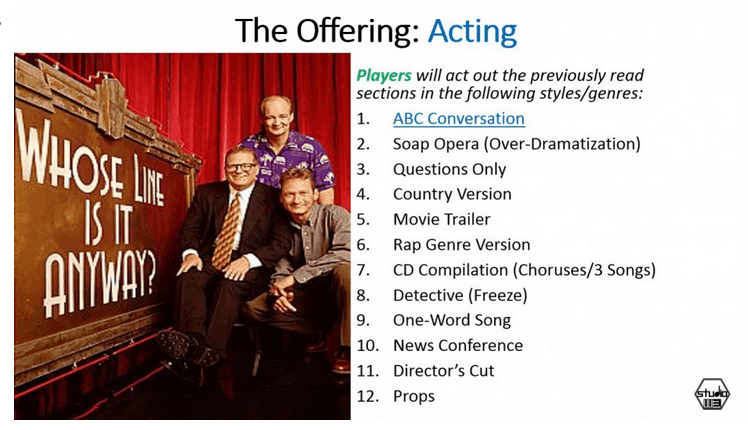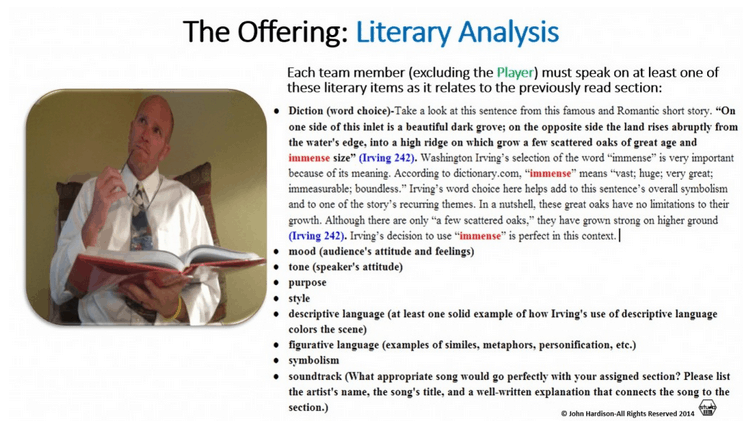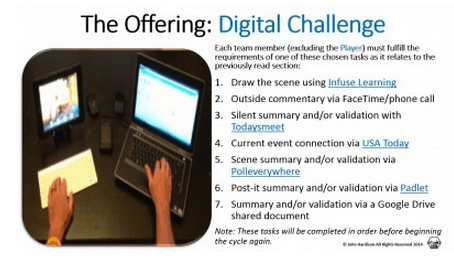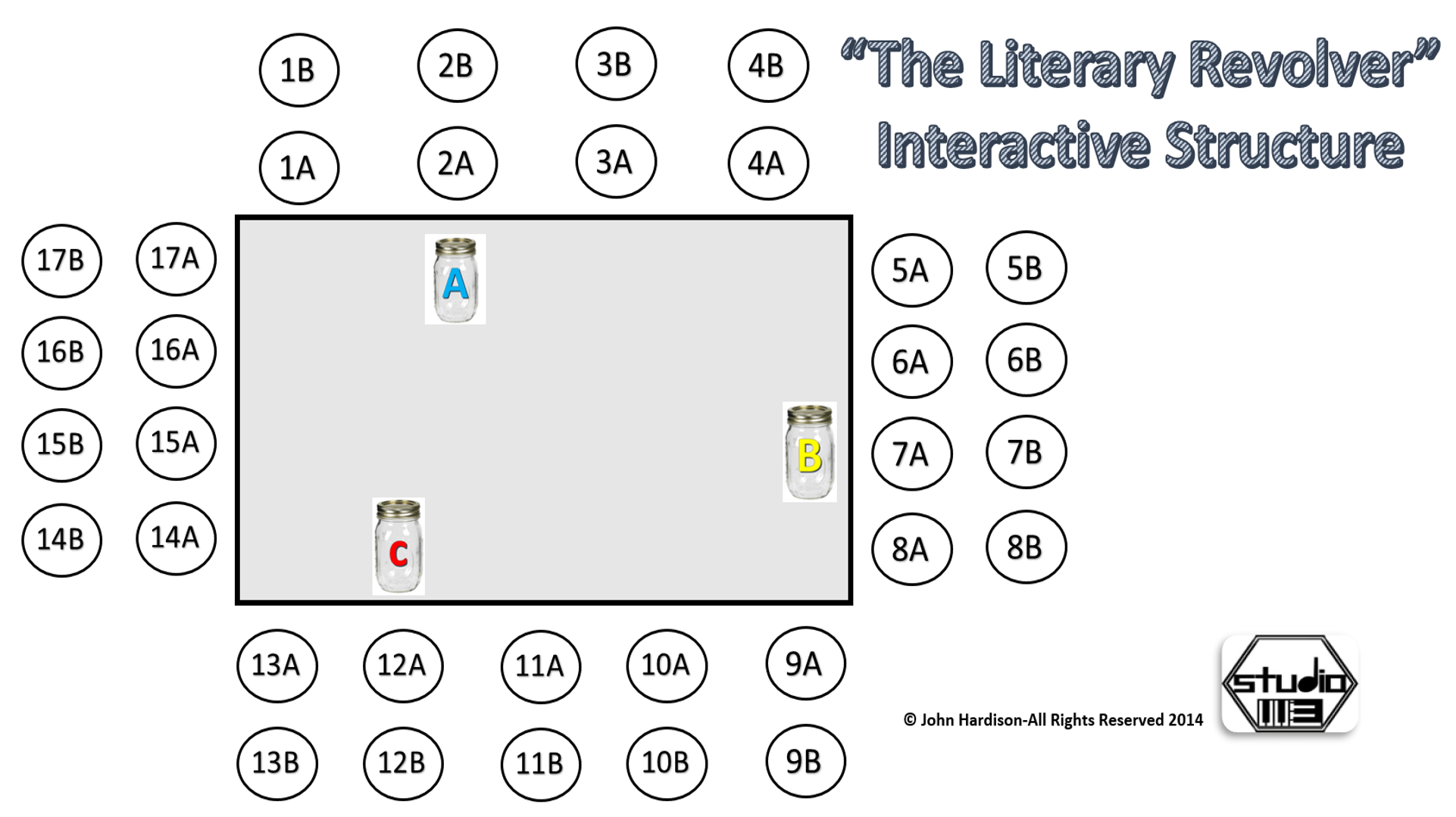First published here on GettingSmart on 2.1.2015
To me, it is indisputable that literature is meant to be brought to life. Easier said than done, though. Such organic rendering of the written word involves courage in the shape of improvisational and planned acting. That is enough to make teenaged students as nervous as Tom Brady and Bill Belichick in a room full of NFL wonks and football pumps. In fact, when faced with a case of the jitter fingers just before turning literature into lifelike visuals, our students attempt to deflate any nervous pressure by responding with the class motto: "<a title="Studio 113's motto "Life is a stage. Step UP."" href="https://twitter.com/JohnHardison1/status/543156745712197632" target="_blank">Life is a stage. Step UP.</a>"
However, sometimes a stage does not suffice for such an arduous task. A location that combines necessary guidelines, exudes toughness, and provides the freedom of a wall-less classroom seems to set the tone for any literature and acting assignment that demands rigor. And one such taxing activity would surely involve demonstrating mastery of the literature by merging collaboration and creativity in a timely manner.
Yep. If you are carrying what I am handing off, you guessed it.
A football field is the perfect space to tackle a gargantuan opponent, such as the <a title="Forrest Gump in 1 Minute and 1 Take" href="http://youtu.be/nOvgJ0TxdfI" target="_blank">1-to-2 minute summary</a>.
Quick. You go long and dive into this blog, and I will pass you the notes.
Break.
<h2><strong>Hut 1: The Assignment</strong></h2>
No need to scream and holler about snappy details like the Dolphins' field goal kicker in <a title="Ace Ventura on Wikipedia" href="http://en.wikipedia.org/wiki/Ace_Ventura:_Pet_Detective" target="_blank">Ace Ventura</a> who cries "Laces out!" However, it is definitely a sane practice to put the purpose of the lesson before the activity. What were my intentions with <a title="Studio 113 at East Hall High School in Gainesville, GA" href="http://teacherpages.hallco.org/webpages/jhardison/index.cfm" target="_blank">Studio 113</a>'s latest assignment in American Literature? To study Dark Romanticism by analyzing the symbolism and numerous themes in Nathaniel Hawthorne's "<a title=""The Minister's Black Veil" on Wikipedia" href="http://en.wikipedia.org/wiki/The_Minister%27s_Black_Veil" target="_blank">The Minister's Black Veil</a>." <a title="60 Seconds & a Camera: Essentials for a Culminating Activity" href="https://www.gettingsmart.com/2013/04/60-seconds-a-camera-essentials-for-a-culminating-activity/" target="_blank">Two years ago</a>, the class challenge was the same but involved Bret Harte's "<a title=""The Outcasts of Poker Flat" on Wikipedia" href="http://en.wikipedia.org/wiki/The_Outcasts_of_Poker_Flat" target="_blank">The Outcasts of Poker Flat</a>," a story of Realism and Naturalism set in the Sierra-Nevada Mountains.
Click <a title=""The Minister's Black Veil" 1-2 Minute/1-Take Summary Assignment" href="https://docs.google.com/presentation/d/1lB_nRJcUHF1uo0M57IJsFx9f9ljGoyEgDkzMjVx00PQ/edit?pli=1#slide=id.g5cb2964df_085" target="_blank">here</a> to see the most recent assignment details. Want to see the video that inspired this project? Click <a title="Forrest Gump in 1 minute and 1 take" href="http://youtu.be/nOvgJ0TxdfI" target="_blank">here</a>. Also, make sure you visit the <a title="60 Second Recap YouTube Channel" href="https://www.youtube.com/user/60SECONDRECAPcom" target="_blank">60 Second Recap YouTube Channel</a>. It rocks.
<h2><strong>Hut 2: The Goal</strong></h2>
After it is all said and done, the students should create 1-to-2 minute summaries that condense their teams' collective analysis of the prescribed literature. To show the students what a glorious score looks and sounds like, I have them view this 1-minute, 1-take summary of <a title="Forrest Gump in One Minute, One Take" href="http://youtu.be/nOvgJ0TxdfI" target="_blank">Forrest Gump</a>. Of course, if you want to really get their attention, witnessing a successful completion from <a title=""The Outcasts of Poker Flat" in Roughly 90 Seconds" href="http://youtu.be/TlnuMfUsZCo" target="_blank">their own peers</a> and their own <a title="East Hall High School in Gainesville, GA" href="http://ehhs.hallco.org/web/" target="_blank">school</a> is the ultimate motivation.
<h2><strong>Hut 3: The Process</strong></h2>
Before the students begin reading the assigned literature, class volunteers are asked to huddle up and participate in a private draft. Of course, it depends on the specifics of the task, but I usually ask the team leaders to select a diverse team of ten to twelve students. I always remind the leaders to pick peers, not just friends, who can build a well-rounded team that is capable of completing a 60 to 120 second analysis. Before wrapping up the drafting procedures, I ask the students to take an oath that all drafting details will remain in the drafting room.
After all teams have been chosen, I give the class some relevant background notes and a few pointers. Then, I turn over the entire process to the team leaders. It is a blast to stand back and watch how each team leader approaches such an intimidating <a title="The 1 to 2 Minute/1 Take Summary Assignment" href="https://docs.google.com/presentation/d/1lB_nRJcUHF1uo0M57IJsFx9f9ljGoyEgDkzMjVx00PQ/edit?pli=1#slide=id.g5cb2964df_085" target="_blank">assignment</a>. Whether all leaders start out loose or too controlling, they all eventually realize that organization, flexibility, and collaboration are the keys to success.
I marvel as students' personalities and talents collide as they follow their peer leaders through the reading, analysis, brainstorming, rehearsal, and eventually, the performance. Talk about a mature and tough assignment. It is a wonder they do not ask for helmets and pads.
<h2><strong>Touchdown: The Examples</strong></h2>
<center><iframe src="https://www.youtube.com/embed/TXjCfF7Jm9g" width="640" height="360" frameborder="0" allowfullscreen="allowfullscreen"></iframe></center><center><iframe src="https://www.youtube.com/embed/ane6QhdCR1k" width="640" height="360" frameborder="0" allowfullscreen="allowfullscreen"></iframe></center><center><iframe src="https://www.youtube.com/embed/tI6M1t6aFjk" width="640" height="360" frameborder="0" allowfullscreen="allowfullscreen"></iframe></center><center><iframe src="https://www.youtube.com/embed/CeYChqXNIAs" width="640" height="360" frameborder="0" allowfullscreen="allowfullscreen"></iframe></center><center><iframe src="https://www.youtube.com/embed/O9x25L8NgRA" width="640" height="360" frameborder="0" allowfullscreen="allowfullscreen"></iframe></center><center><iframe src="https://www.youtube.com/embed/iNssDozHYSs" width="640" height="360" frameborder="0" allowfullscreen="allowfullscreen"></iframe></center>
<h2><strong>The Point After: Pros and Cons</strong></h2>
Creativity takes time. I guess that is why no standardized test ever spawned a major invention. Honestly speaking, if you are concerned with how much you cover in class versus the depth of knowledge and creativity, this assignment should probably be removed from your playbook. But if offering real-world challenges that transcend the "A, B, C, D" multiple-choice bubbles sounds like a game plan, you should call an audible and pass off a 1-minute analysis to your students.
Believe me, it is sure to be an <a title="The NFL and the Pittsburgh Steelers: Naming the Immaculate Reception" href="http://www.nfl.com/videos/pittsburgh-steelers/0ap2000000113831/A-Football-Life-Naming-the-Immaculate-Reception" target="_blank">immaculate reception</a>.
For more blogs by John Hardison, check out:
<ul>
<li><a href="https://www.gettingsmart.com/2015/01/students-spoken-will-listen/" target="_blank"> The Students Have Spoken: Will You Listen?</a></li>
<li><a href="https://www.gettingsmart.com/2014/12/bringing-literature-life-can-square/" target="_blank">Bringing Literature to Life Can Be Square</a></li>
<li><a href="https://www.gettingsmart.com/2014/12/todays-educator-jack-trades-master-one/" target="_blank">Today's Educator: A Jack of All Trades and Master of One</a></li>
</ul>






